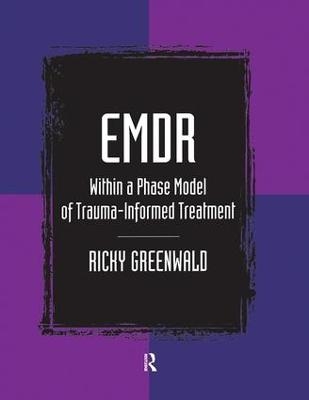
EMDR Within a Phase Model of Trauma-Informed Treatment
Routledge (Verlag)
978-0-7890-3216-4 (ISBN)
A practical guide to learning and using EMDR! Trauma is a potential source of most types of emotional or behavioral problems. Extensive research has shown EMDR to be an effective and efficient trauma treatment. EMDR Within a Phase Model of Trauma-Informed Treatment offers mental health professionals an accessible plain-language guide to this popular and successful method. The book also introduces the “Fairy Tale Model” as a way to understand and remember the essential phases of treatment and the tasks in each phase.
This manual teaches a clear rationale and a systematic approach to trauma-informed treatment, including often-neglected elements of treatment that are essential to preparing clients for EMDR. The reader is led step by step through the treatment process, with scripted hands-on exercises to learn each skill. In addition to presenting the fundamental EMDR procedures, EMDR Within a Phase Model of Trauma-Informed Treatment teaches a treatment system that can be applied to a variety of cases. Using research-supported and proven-effective methods, this book takes you through the treatment process with easily-understood dialogues and examples. Explicitly guided exercises produce hands-on skills and familiarize you with ways to explain trauma to clients and prepare them for EMDR. You will also learn to problem-solve challenging cases using the trauma framework. EMDR Within a Phase Model of Trauma-Informed Treatment also includes an Instructor’s Manual with:
sample syllabus
teaching tips
PowerPoint slides
test bank.
Additional discussions address:
why trauma matters
posttraumatic symptoms
the “trauma wall”
the structure of trauma treatment
the role of EMDR
the eight phases of EMDR
preparing clients for EMDR
legal and medical issues in EMDR
problem solving strategies in EMDR sessions
treatment strategies for a variety of presenting problems
using EMDR with children and adolescents
use and application of the “fairy tale model”
on-line and digital resources
Designed to be a comprehensive primer, companion/supplemental textbook, and valuable reference resource, EMDR Within a Phase Model of Trauma-Informed Treatment is ideal for clinicians already trained in EMDR, those actively learning EMDR, and mental health professionals interested in EMDR. Note that to practice EMDR requires formal supervised training.
Dr. Ricky Greenwald is a practicing clinical psychologist who has been working with children, teens, adults, and families since 1985. He is the Trauma Institute & Child Trauma Institute‘s founder, executive director, and chair of faculty.
SECTION I: TRAUMA-INFORMED TREATMENT AND EMDR
Chapter 1. Understanding Trauma
Why Trauma Matters
A Useful Definition of Trauma
What Makes an Event Traumatic?
The “Trauma Wall”
Resiliency and Vulnerability
Safety and Attachment
Posttraumatic Symptoms
Posttraumatic Symptoms over Time
A Note on Exercises/Activities in this Book
Exercise: Float-Back
Chapter 2. The Structure of Trauma Treatment
Meaning of Behavior
Selecting a Trauma Treatment Structure
Chapter 3. The Role of EMDR
Exposure
EMDR
Adaptive Information Processing Theory
The EMDR Protocol: The Eight Phases of Treatment
EMDR and Other Therapy Approaches
EMDR and the Fairy Tale Model
SECTION II: PHASE 1—CLIENT HISTORY AND TREATMENT PLANNING
Chapter 4. The Initial Interview: From “Hello” to History
Acculturation
Therapist Style
Introducing Treatment
The Rules
Individual Interview Strategies
How Much Should the Client Talk?
Obtaining More History While Focusing on Strengths
Chapter 5. Taking a Trauma History
Exercise: Take a Trauma/Loss History
Exercise Follow-Up Questions
Chapter 6. Trauma-Informed Case Formulation
Exercise: Do It Yourself
Chapter 7. Making a Treatment Contract
Motivation Enhancement
Finding the Princess
Treatment Planning and Contracting
Presenting the Treatment Plan
Obstacles to Following Through with the Contract
SECTION III: PHASE 2—CLIENT PREPARATION
Chapter 8. Safety and Stabilization
Avoiding High Risk
How Long Does Fence-Around Take?
Clients in Perpetual Crisis
Routines for Starting and Ending the Session
Fence-Around in the Session
Chapter 9. Resource Development and Installation
Introducing Eye Movements
Exercise: Practice Eye Movements
The Safe Place Visualization
Exercise: Safe Place
Safe Place Script
Problem Solving the Safe Place Intervention
Resource Development and Installation
Exercise: Resource Development and Installation
Exercise: Using the Resource in a Positive Template
Chapter 10. Self-Management Training
Self-Management of Anxiety Symptoms
Self-Control of Behavioral Choices
Choices Have Consequences
Exercise: Map Out a Problem
Chapter 11. Precautions for EMDR
Legal Issues
Medical Issues
Self-Control Issues
Secondary Gain
Timing
Dissociation
Dissociative Experiences Scale (DES) Information
Chapter 12. Final Preparations for EMDR
Reorient to the Treatment Plan
Target Order
Introducing EMDR
Accessing Resources
Exercise: Stop Means Stop and Safety Device
Stop Means Stop
Safety Device
Discussion
SECTION IV: PHASES 3-8—TRAUMA RESOLUTION
Chapter 13. Phase 3: Assessment, or “Setting Up the Target”
Exercise: Practice Target Setup
Discussion
Chapter 14. Phases 4 to 5: Desensitization and Installation
Preparing the Client
Doing the Eye Movements (EM)
Some Tips and Reminders
Exercise: Practice EMDR
Discussion
Chapter 15. Phases 6 to 7: Body Scan and Closure
Body Scan
Checks on Completion
Closure
Exercise: Container
Discussion Questions
Closure for All Sessions
Exercise: Practice EMDR
Chapter 16. Phase 8: Reevaluation and Consolidation of Gains
Reevaluation
Exercise: Reevaluation
Using the Float-Back
Exercise: Float Back and EMDR
Consolidation of Gains
Other Aspects of Daily Functioning
Anticipating and Preparing for Future Challenges
Ending Treatment
SECTION V: ADVANCED EMDR APPLICATIONS
Chapter 17. Problem Solving in an EMDR Session
When the Client Is Stuck
Other Challenges and Strategies
| Erscheint lt. Verlag | 8.8.2007 |
|---|---|
| Verlagsort | New York |
| Sprache | englisch |
| Maße | 216 x 276 mm |
| Gewicht | 720 g |
| Themenwelt | Medizin / Pharmazie ► Medizinische Fachgebiete ► Notfallmedizin |
| Medizin / Pharmazie ► Medizinische Fachgebiete ► Psychiatrie / Psychotherapie | |
| Sozialwissenschaften ► Soziologie | |
| ISBN-10 | 0-7890-3216-3 / 0789032163 |
| ISBN-13 | 978-0-7890-3216-4 / 9780789032164 |
| Zustand | Neuware |
| Haben Sie eine Frage zum Produkt? |
aus dem Bereich


